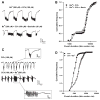Involvement of inward rectifier and M-type currents in carbachol-induced epileptiform synchronization
- PMID: 21144855
- PMCID: PMC4884090
- DOI: 10.1016/j.neuropharm.2010.11.023
Involvement of inward rectifier and M-type currents in carbachol-induced epileptiform synchronization
Abstract
Exposure to cholinergic agonists is a widely used paradigm to induce epileptogenesis in vivo and synchronous activity in brain slices maintained in vitro. However, the mechanisms underlying these effects remain unclear. Here, we used field potential recordings from the lateral entorhinal cortex in horizontal rat brain slices to explore whether two different K(+) currents regulated by muscarinic receptor activation, the inward rectifier (K(IR)) and the M-type (K(M)) currents, have a role in carbachol (CCh)-induced field activity, a prototypical model of cholinergic-dependent epileptiform synchronization. To establish whether K(IR) or K(M) blockade could replicate CCh effects, we exposed slices to blockers of these currents in the absence of CCh. K(IR) channel blockade with micromolar Ba(2+) concentrations induced interictal-like events with duration and frequency that were lower than those observed with CCh; by contrast, the K(M) blocker linopirdine was ineffective. Pre-treatment with Ba(2+) or linopirdine increased the duration of epileptiform discharges induced by subsequent application of CCh. Baclofen, a GABA(B) receptor agonist that activates K(IR), abolished CCh-induced field oscillations, an effect that was abrogated by the GABA(B) receptor antagonist CGP 55845, and prevented by Ba(2+). Finally, when applied after CCh, the K(M) activators flupirtine and retigabine shifted leftward the cumulative distribution of CCh-induced event duration; this effect was opposite to what seen during linopirdine application under similar experimental conditions. Overall, our findings suggest that K(IR) rather than K(M) plays a major regulatory role in controlling CCh-induced epileptiform synchronization.
Copyright © 2010 Elsevier Ltd. All rights reserved.
Figures







References
-
- Andreasen M, Skov J, Nedergaard S. Inwardly rectifying K+ (Kir) channels antagonize ictal-like epileptiform activity in area CA1 of the rat hippocampus. Hippocampus. 2007;17:1037–1048. - PubMed
-
- Armand V, Rundfeldt C, Heinemann U. Effects of retigabine (D-23129) on different patterns of epileptiform activity induced by 4-aminopyridine in rat entorhinal cortex hippocampal slices. Naunyn Schmiedebergs Arch Pharmacol. 1999;359:33–39. - PubMed
-
- Bowery NG, Enna SJ. Gamma-aminobutyric acid(B) receptors: first of the functional metabotropic heterodimers. J Pharmacol Exp Ther. 2000;292:2–7. - PubMed
-
- Bymaster FP, Carter PA, Yamada M, Gomeza J, Wess J, Hamilton SE, Nathanson NM, McKinzie DL, Felder CC. Role of specific muscarinic receptor subtypes in cholinergic parasympathomimetic responses, in vivo phosphoinositide hydrolysis, and pilocarpine-induced seizure activity. Eur J Neurosci. 2003;17:1403–1410. - PubMed
-
- Carr DB, Surmeier DJ. M1 muscarinic receptor modulation of Kir2 channels enhances temporal summation of excitatory synaptic potentials in prefrontal cortex pyramidal neurons. J Neurophysiol. 2007;97:3432–3438. - PubMed
Publication types
MeSH terms
Substances
Grants and funding
LinkOut - more resources
Full Text Sources

